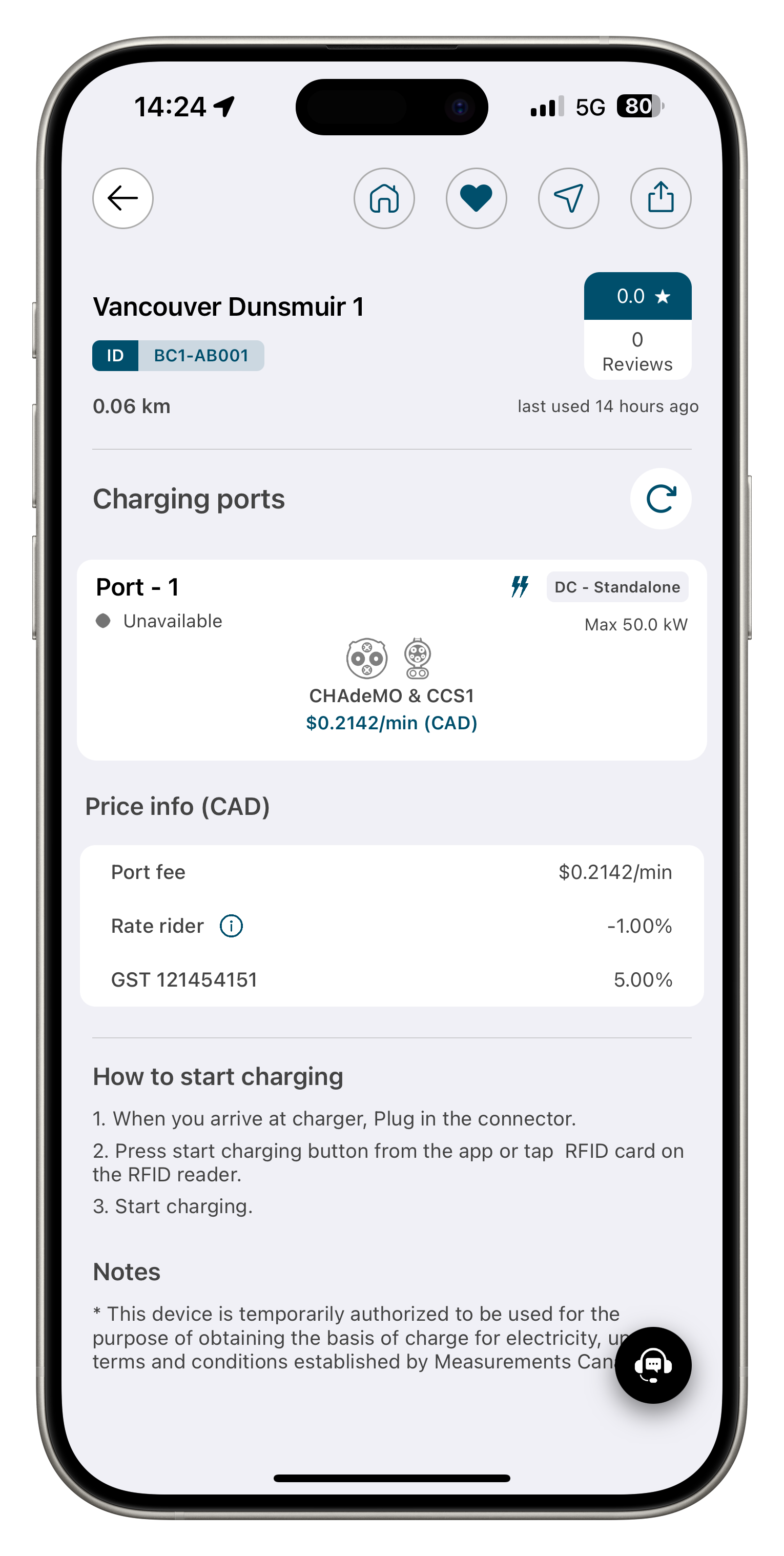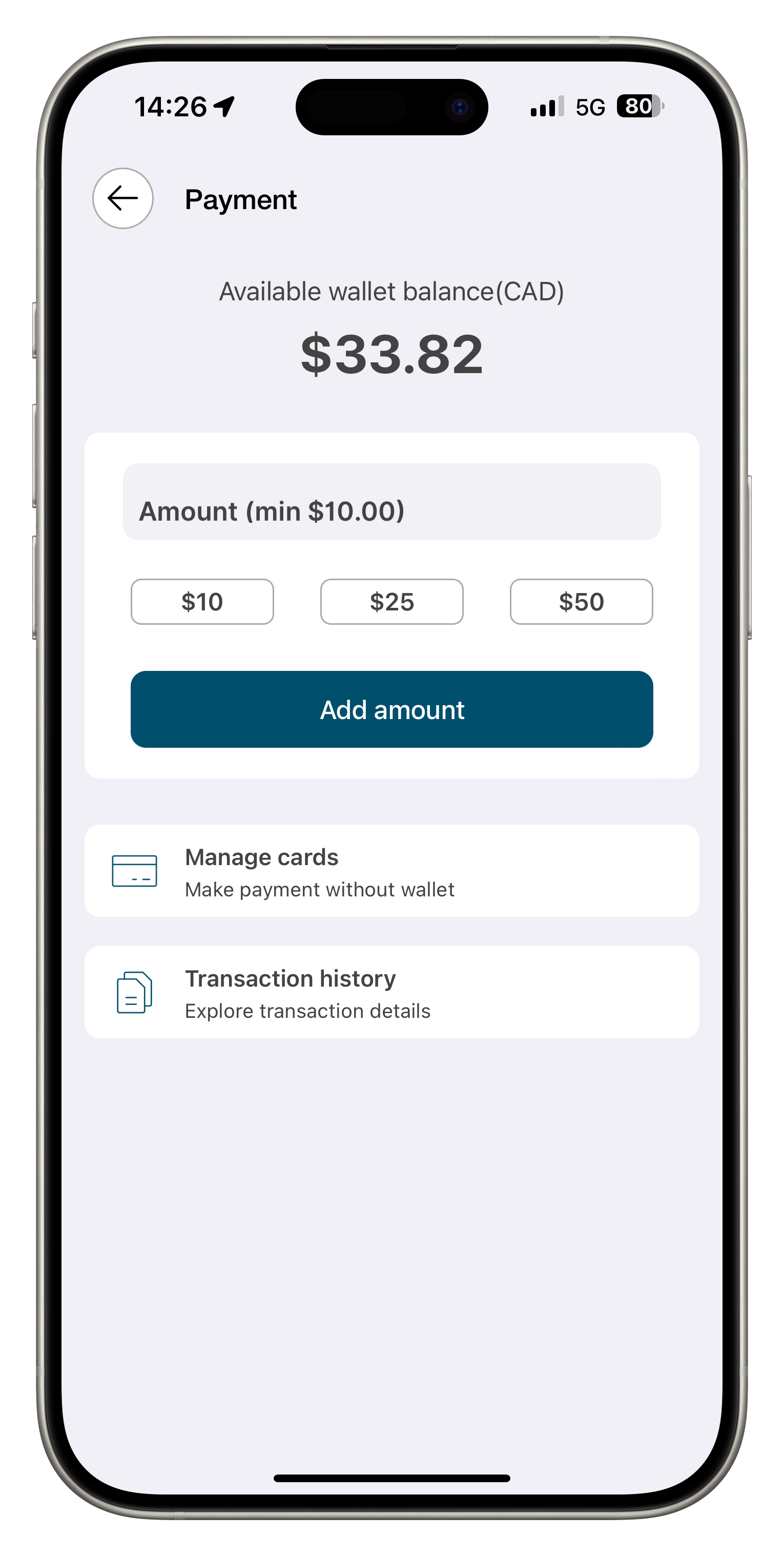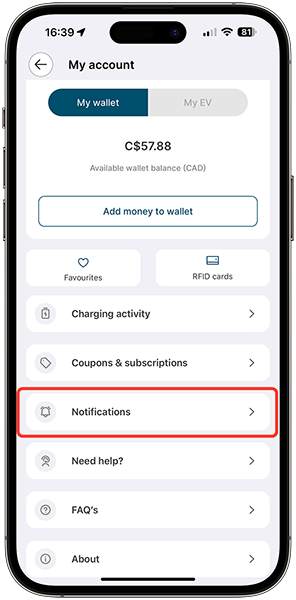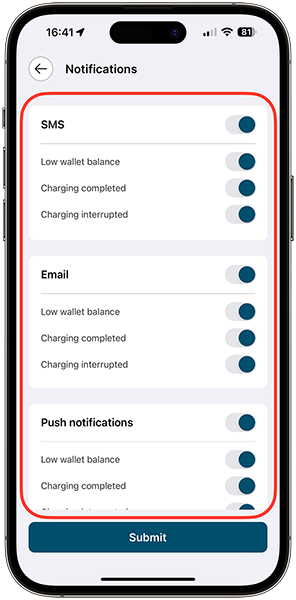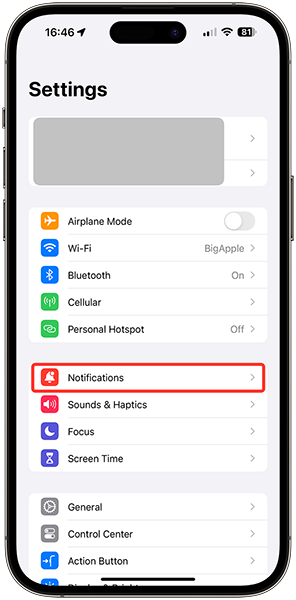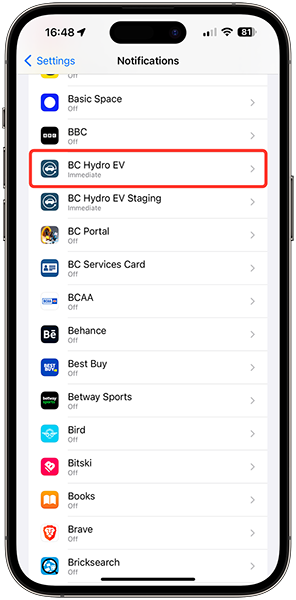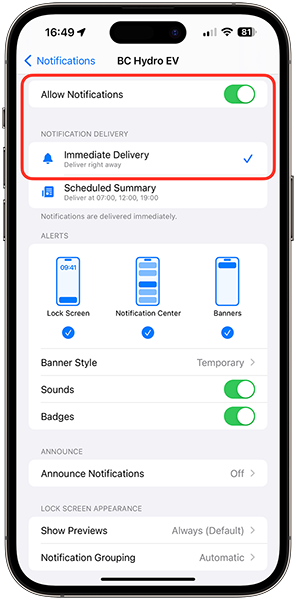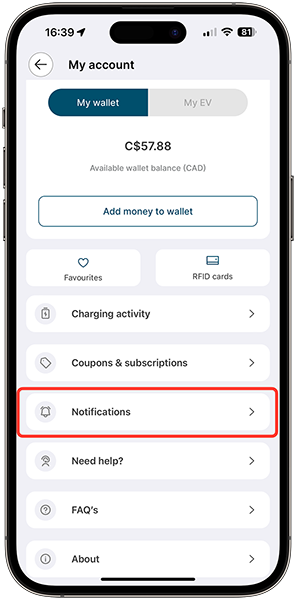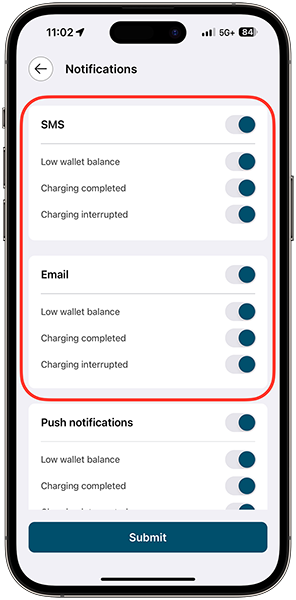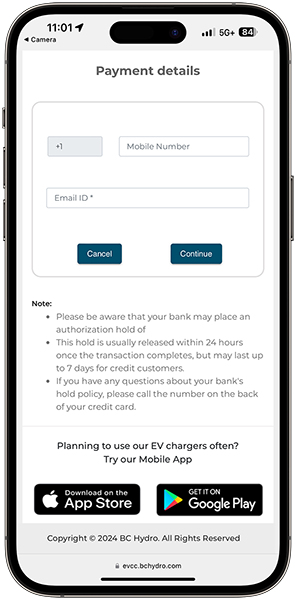How to use BC Hydro EV chargers
If you're new to using a fast charger, or need help, we've got you covered. Our help centre provides assistance with charging basics, questions about charging costs, and our mobile app.
The basics
In order to use a charger, your vehicle needs to have either a Combo (CCS), CHAdeMO, a J1772 or a Tesla North American Charging Standard (NACS) compatible port. These are the four different charger types available at charging sites in B.C. Check your port to see if it can connect to any of the four EV connectors pictured below.

Step 1: Connect
Park your vehicle and turn it off. Next, open the charging port on your vehicle. Remove the appropriate connector from the charger (CCS, CHAdeMO, Tesla North American Charging Standard, or J1772 depending on your car) and plug it into your vehicle.
Step 2: Charge
Start the charge by using one of these three methods and following on-screen prompts:
- Use the appropriate mobile application for the specific fast charger.
- Get the BC Hydro EV app for BC Hydro chargers (also supports roaming partner chargers)
- Use another app that's supported by the BC Hydro EV network
- Use a network-specific RFID card to activate the charging process. If charging doesn't start automatically, follow the prompts on the screen to begin charging.
- Get the BC Hydro EV RFID card
- Use the start button on the charger or touchscreen. If charging doesn't start automatically, follow the prompts on the screen to begin charging.
Step 3: End the charge
There are two methods you can use to end the charging session if it doesn't end automatically:
- Use the appropriate mobile application for the specific fast charger.
- Use the stop button on the charger or touchscreen.
Step 4: Remove the plug
Once you've ended the charge, the plug will unlock. Remove the plug from your car and replace it on the charger.
Watch: EV public charging explained
Dave shows how to get connected with our network – via the mobile app or RFID card – and what to do when you get to the charger.
Each location is different, and there may be restaurants, shops, parks, and other fun or productive things to do in the area while you wait.
Check the PlugShare mobile app or website to see what amenities are in the area, but be sure to move your vehicle once charged to make the charger available to others.
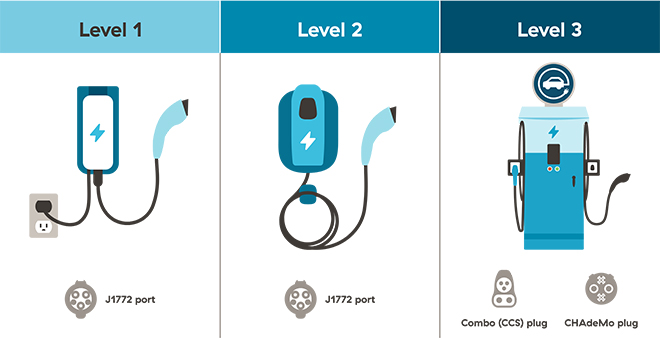
Level 1
- 120V wall outlet, 1 kW
- Compatible with all EVs
Suitable for
- Home, work, public station
- Overnight or long-term parking
- Top-ups
Level 2
- 240V stove outlet, 3 – 6 kW
- Compatible with all EVs
Suitable for
- Home, work, public station
- Overnight or long-term parking
- Installation at home
Level 3 (fast charge)
- 480+V, 25 kW, 50+ kW
- Compatible with battery electric vehicles with fast charging feature (check with manufacturer for details)
Suitable for
- Businesses and public charging sites
- Short-term parking
- On the road
*Actual charging times will vary depending on battery size and health
Register for an EV account
Register for a BC Hydro EV account before you leave to save time. You can do this from the BC Hydro EV website or the BC Hydro EV app. You can also order a BC Hydro EV RFID card if you'd like to start a charge with a card instead of the mobile app.
Pre-loaded account balance
The BC Hydro EV network uses a pre-loaded account balance approach. This is similar to many other EV networks. To use our chargers, you'll need to register your credit card through the app or website and pre-load your account balance ahead of time. Our call centre agents are unable to take your credit card information over the phone.
Our new 200 kW fast chargers feature an integrated battery that speeds up charging, allowing your vehicle to charge more quickly, even at locations where fast charging is traditionally unavailable. When you connect your EV, you can receive up to 200 kW from the CCS connector or 100 kW from the CHAdeMO connector, depending on your vehicle.
When the charger's integrated battery drops below 10%, it activates Power Conservation Mode. In this mode, connected EVs will continue to charge, but speeds will decrease to allow the charger's battery to recharge from the grid. This is necessary to maintain faster charging speeds outside of Power Conservation Mode. Fast charging speeds will resume once the charger's battery reaches 15%.
Power sharing helps us provide charging to more EV drivers at once. Our fast chargers with power sharing capabilities split the available power between two vehicles if both need to use the same charger at the same time.
For example, if you're using one of our 180 kW fast chargers, the charger may split power between two vehicles, sending up to 90 kW to each.
If you're using one of our battery-integrated 200 kW fast chargers (coming soon), the charger may split power between two vehicles, sending up to 100 kW to the CCS connector and 100 kW to the CHAdeMO connector.
Under our energy-based rates, the cost for charging is based on the amount of energy delivered to your vehicle and isn't impacted by power sharing.
Mobile app
Mobile application
The BC Hydro EV app indicates when BC Hydro chargers are in use or available.
PlugShare
The PlugShare map and mobile app can be used to find information about the availability of all other chargers.
This is an international crowd-sourced tool that's updated by EV users who voluntarily contribute. Like any crowd-sourced tool, the information may sometimes be out-of-date, but users often indicate when a charger is unavailable.
You don't need to register to use PlugShare unless you'd like to check in at a charger location and leave notes for others.
Mobile application
You can find all BC Hydro EV chargers by using the BC Hydro EV app. You can also use our roaming partner chargers with the BC Hydro EV app.
PlugShare
The PlugShare map and mobile app can be used to find a charger across all EV networks.
This is an international crowd-sourced tool that shows the locations of EV chargers that can be filtered by region, connector type, and network. You don't need to register to use PlugShare unless you'd like to check in at a charger location and leave notes for others.
Starting the charge
Chargers support different global standard EV charge connectors; the Combo (CCS),CHAdeMO, J1772 and the Tesla North American Charging Standard (NACS). You can charge your EV at a charger if any of these connectors can plug into your car.
Some vehicles, such as select Tesla models, require an adapter to plug into a charger that is not operated by Tesla.

You'll need to turn off your vehicle in order to start a charge. After you've started the charge, you may be able to turn power back on to run the heat or radio, but power steering and the ability to move the vehicle will be disabled until you've stopped charging.
Please refer to your owner's manual as each vehicle may have different settings.
Step 1: Select the right connector
Start by removing either the Combo (CCS), the CHAdeMO, the Tesla North American Charging Standard (NACS) or J1772 connector from the charger (check your car to see which one it uses). You may need to press down on a button on the handle to release the connector from the charger. If you have a Tesla, you may need a CHAdeMO adapter as well.
Step 2: Align the connector
Align the connector with your car's port, and push firmly until it's fully inserted. This may require a bit of force, but be gentle so as not to damage the equipment or your vehicle's port. Ensure that the cable is not fully stretched as this would make it difficult to remove from your vehicle after charging has been completed.

Unless the connector is locked to the charger, begin by removing the connector from the charger and plugging it into your car. If the connector is locked, you'll need to initiate the charge first, and then plug the connector into your car once it's released.
Method 1: Mobile app
Use the appropriate mobile app for the specific charger.
- Get the BC Hydro EV app for BC Hydro chargers (also supports roaming partner chargers)
- Use a roaming partner app that's supported by the BC Hydro EV network
Method 2: RFID Card
Hold the RFID card against the reader to activate the charging process. If charging doesn't start automatically, follow the prompts on the screen to begin charging.
- Get the BC Hydro EV RFID card
Method 3: Manual
Use the start button on the charger or touchscreen. If charging doesn't start automatically, follow the prompts on the screen to begin charging.
Up until 2023 our chargers had just one connector, meaning only one EV could be charged at a time.
In December 2023, we introduced faster charging with new 180 kW chargers. These chargers have power sharing capabilities, meaning more than one vehicle can split the 180 kW charge at the same time. These faster chargers will be well marked, so look for them at select sites, or use the BC Hydro EV network app to locate them.

Most chargers can be activated with a mobile app, or by scanning the QR code with your phone's camera.
The BC Hydro EV app will activate our EV chargers, as well as our roaming partner chargers. Ensure you have enough balance pre-loaded in your account.
Check PlugShare ahead of time to see what network the charger is on. If the charger is not on the BC Hydro EV or roaming partner networks, you may have to download a network-specific app to activate it.
Yes, EV chargers are safe to use in the rain and snow.
Ending the charge
Please see the signage at the charging site for parking etiquette. In general, we recommend the below time limits based on charger power level, particularly when another vehicle is waiting:
- 25 kW: one hour
- 50 kW: 40 minutes
- 100 kW: 30 minutes
- Higher power levels: less than 30 minutes
There are two methods you can use to end the charging session if it doesn't end automatically.
- Use the appropriate mobile application for the specific charger.
- Use the stop button on the charger or touchscreen.
If you have any problems please reach out to our support center for help.
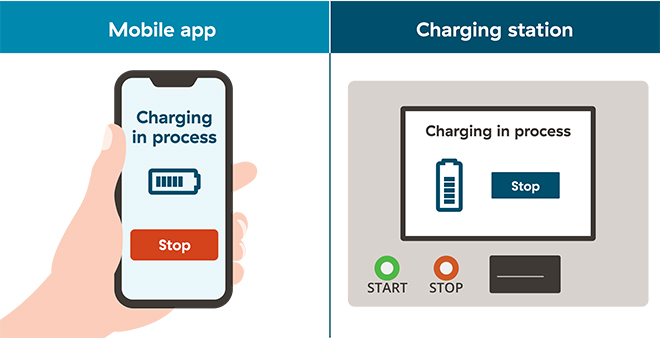
To remove the connector once your charge is done, pull it out of the vehicle. Depending on the connector type, you may need to push a button in order to release the connector before pulling it out.
Power Level (Kilowatts) |
Estimated time to charge from 30% to 80%* | Maximum visit time |
|---|---|---|
| 25 kW | 40 to 80 minutes | 60 minutes |
| 50 kW | 30 to 60 minutes | 40 minutes |
| 100 kW+ | 20 to 40 minutes | 30 minutes |
*Varies, see factors below.
Factors that influence charge time
Charging time will depend on your battery's state of charge (how full it is), your battery size and environmental factors such as outside air temperature. Every make and model is different, and you'll get to know your car after you've used a charger a few times.
Charging over 80%
Even when using a fast charger, charging will usually slow down for most vehicles when capacity passes 80%. This "trickle charge" is related to the vehicle, not the charger. To continue charging over 80%, we recommend moving to a Level 2 charger which provides a lower charging cost, and will free up the charger for others.
If your vehicle is unplugged during a charge, you'll need to plug it back in and start a new charge.
It's unlikely that someone will unplug your vehicle while it's charging. Many EVs are equipped with locks and/or alarms to prevent or discourage it.
Paying
The BC Hydro EV app will indicate the price to charge at our chargers, as well as chargers within the roaming partner networks. All BC Hydro EV chargers have signage that indicates the pricing.
|
To start a charge, your account balance must be greater than $0. When adding funds, you'll need to add $20 or more at a time.
You need a credit card to load funds onto your BC Hydro EV account.
To load funds through the mobile app
- Open the app on your mobile phone and go to the My Account menu.
- Select Add money to wallet.
- Choose or enter the amount of money you'd like to add to your account balance. Then select Add amount. You can also select Auto reload to ensure your account is always topped up and ready to go.
Choose a payment method, enter your credit card information and select Confirm.
|
To load funds through the website
- Log in to your BC Hydro EV account.
- Select Payment from the sidebar menu. Then select Add balance. You can also select Auto reload to ensure your account is always topped up and ready to go.
- Choose or enter the amount of money you'd like to add to your account balance. Then select Proceed to payment.
Enter your credit card information and select Place order.
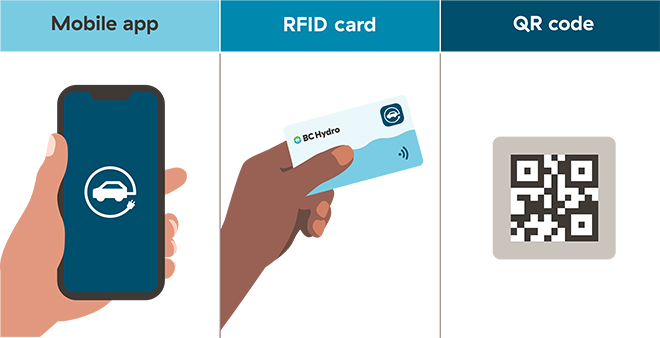
If a charger requires payment, there are a few ways in which you can pay for the charge:
Option 1: Mobile application
Use the network-specific mobile app to set up a payment method within the app (see app for payment options).
- Get the BC Hydro EV app for BC Hydro chargers (also supports roaming partner chargers)
- Use another roaming partner app that's supported by the BC Hydro EV network
Option 2: RFID Card
Order a network-specific RFID card and load funds onto it. This card can then be used at a charger for payment.
- Get the BC Hydro EV RFID card
Option 3: QR Code
Scan the QR code on the charger sticker.
- BC Hydro EV chargers allow you to activate a charging session without a membership or RFID card.
- Scan the QR code with your mobile phone camera and follow the prompts to activate without a membership.
- You may see a $40 pending transaction on your credit card. This is a temporary hold which will be cleared once our payment system processes the cost and payment of your actual charging session.
In many cases, the network-specific mobile application can be used at a charger instead of an RFID card.
However, we recommend also having a network-specific RFID card for cases in which you're unable to access the mobile app (e.g. your phone battery dies, or you're in an area where you don't have mobile/internet connectivity).
Option 4: Credit or debit card
We're starting to roll out card readers at our EV chargers. Customers will be able to pay using their debit or credit cards. Just follow the step by step instructions on the charger.
An idle fee is an additional cost that's applied to your charging session bill. This fee is applied when your vehicle stays connected to the fast charger after it has finished charging, preventing other drivers from using the charger.
Idle fees encourage considerate EV charging etiquette, shorten wait times, and help to promote efficient use of our fast charging sites.
How much is the idle fee
Effective May 1, 2024, the idle fee is:
EV charger power level |
Idle fee (before tax) |
|---|---|
| Fast charging | $0.40 per minute |
| Level 2 | Not applicable. Please be courteous to other drivers and move your vehicle as soon as it's done charging. |
How it works
Once your vehicle stops charging, you have five minutes to disconnect before you'll be charged the idle fee.
For example, if your vehicle finishes charging at 10 a.m. but remains connected to our fast charger until 10:20 a.m., you'll be charged an idle fee of $6 (before tax).
- Five minute grace period: no fee
- 15 minutes of non-charging idle time at $0.40 per minute: $6 idle fee.
Idle fees are billed on a prorated, per-second basis, to the nearest minute.
Idle fee notifications for app users
As a BC Hydro EV app user, you can choose to be notified by either email, text (SMS) or Push notifications when your vehicle stops charging and when idle fee billing starts.
To select how you'd like to be notified, login to the EV app, select My Account, and select Notifications.
|
|
If you're using an iOS or similar Google OS device, check that your device's Notifications preferences are also set to receive Push notifications.
|
|
|
Idle fee notifications for RFID users
As a BC Hydro EV RFID card user, you can choose to be notified by email or text (SMS) when your vehicle stops charging and when idle fee billing starts.
To select how you'd like to be notified, login to the EV app, select My Account, and select Notifications.
|
|
Or log into your BC Hydro EV account on your desktop platform. Then, select Profile and select Notifications.
Idle fee notifications for one-time credit card payments
If you activate your charging session through a one-time credit card payment (using the QR code on the charger), you'll need to provide your mobile number and email under Payment details when authorizing the session on your mobile phone. You'll received notifications when your vehicle stops charging and when idle fee billing starts via email or text (SMS).
|
Idle fee notifications on roaming partner apps
The idle fee notification feature isn't currently available through our roaming partner apps.
How to view your transaction history
You'll receive a charging activity email summary detailing the total cost of your session, including any applicable idle fees. This will be shared with you at the end of your BC Hydro EV charging session.
You can also download your transaction and payment history anytime by logging into your EV account.
Notice of EV charging rate change - May 1, 2024
Effective May 1, 2024, the costs to charge at BC Hydro chargers are:
Type of charge |
Price (before tax) |
|---|---|
| Level 2 charging | $0.2865 per kWh |
| Fast charging (25 kW+) | $0.3479 per kWh |
| Idle fee* | $0.40 per minute |
* Once your vehicle stops charging, you'll have five minutes to disconnect before you're charged an idle fee. Idle fees apply at all BC Hydro chargers, except Level 2 chargers.
Charging rates are based on the labelled maximum kW output of the charger, not on actual kW output received or requested by the vehicle. These rates are approved by the B.C. Utilities Commission.
Each session at our chargers is billed per second. Following your charging session, you'll receive an emailed receipt with a breakdown of your charge, including how long you charged for (in minutes and seconds), and the session cost and any idle fees before and after 5% GST is applied. You can also download your transaction and payment history (including tax details) through your BC Hydro EV account.
Authorization from Measurement Canada
Our public chargers are temporarily authorized to be used for the purpose of obtaining the basis of a charge for electricity, under terms and conditions established by Measurement Canada.
Third-party fees
Parking fees may apply
Note that charger rates don't include parking fees. Be sure to check signage or PlugShare to see if a specific charger requires payment for parking. Currently the following sites have a parking fee that's collected by the site host:
- Nanaimo Public Parking — Museum Way
- Port Coquitlam — Translink Park & Ride (Level 2 charging)
- Vancouver — Homer Street (collected by the City of Vancouver)
- Vancouver — Kerrisdale (collected by the City of Vancouver)
- Whistler Conference Centre
For other charging networks in B.C., check PlugShare to find locations, charging costs and parking fees before you go.
Roaming fees may apply
For up-to-date rates for our roaming partner networks, please refer to the pricing information for individual chargers on the BC Hydro EV app. Please note that rates vary depending on the charging network you're using.
When charging through ChargeHub roaming partner networks, roaming fees will be added to the charging cost. These fees are:
- $1.25 (tax inclusive) for fast chargers
- $0.75 (tax inclusive) for Level 2 chargers
Please call our charging support centre at 1 866 338 3369 for assistance.
Effective May 1, 2024, our public EV chargers use energy-based billing ($ per kWh) instead of time-based billing ($ per minute). The costs to charge at BC Hydro chargers are:
Type of charge |
Price (before tax) |
|---|---|
| Level 2 charging | $0.2865 per kWh |
| Fast charging (labelled 25 kW or higher) |
$0.3479 per kWh |
| Idle fee | $0.40 per minute |
Charging rates are based on the labelled maximum kW output of the charger, not on actual kW output received or requested by the vehicle. These rates are approved by the B.C. Utilities Commission.
We made the change in response to customer feedback and industry best practice. Under time-based billing, the cost to charge at a public charger could vary due to vehicle and battery size, the beginning and ending state of charge (i.e. battery percentages), and the temperature. Switching to energy-based billing ($ per kWh) removes these variables.
Authorization from Measurement Canada
Our public chargers are temporarily authorized to be used for the purpose of obtaining the basis of a charge for electricity under terms and conditions established by Measurement Canada.
As of April 1, 2024, a negative 4.8% rate rider applies to the cost of all electric vehicle (EV) fast charging sessions on our network.
A rate rider is applied to the total of all charges, before taxes. It can be a negative or positive amount. Amounts received from a positive rate rider are used to recover additional and unpredictable energy costs. These include low water inflows and higher-than-forecast market prices. The rate rider is set by the B.C. Utilities Commission.
As of January 25, 2024, you'll no longer see a separate rate rider line item in your emailed receipt. Instead, this amount is now included in the displayed charging session cost.
Something's not working
Three methods to start a charge
Method 1: Mobile app
Use the appropriate mobile app for the specific charger.
Method 2: RFID Card
Hold the RFID card against the reader to activate the charging process.
Method 3: Manual
Use the start button on the charger or touchscreen.
If an error message appeared when you tried using one method to start the charge, we recommend unplugging your vehicle, plugging it back in, and trying to start a charge using a different method.
If this doesn't resolve the issue, please call BC Hydro to report the problem at 1 866 338 3369.
Try maneuvering your car so that your charging port is as close to the charger as possible. If it still doesn't reach your port, please call BC Hydro to report the problem at 1 866 338 3369.
If the equipment is damaged, please call BC Hydro to report the problem at 1 866 338 3369.
If the charger is out of service, please call BC Hydro to report the problem at 1 866 338 3369.
Don't unplug another driver's vehicle. Doing so could damage the vehicle or the charger.
There are time limits in place, but if you don't have time to wait we recommend looking for other chargers nearby. Always ensure your vehicle is safely parked and turned off before searching for chargers on your mobile app.
There are many factors that influence the range (or distance) you can get on a full charge. You may experience shorter ranges due to:
- Elevation gains
- Cold temperatures
- Auxiliary systems like air conditioning or heating
- Increased weight in the car
The more work your car needs to do, the more quickly it uses energy. This means a shorter distance that can be travelled on a full charge.
Not finding what you need?
Contact the support centre: 1 866 338 3369
